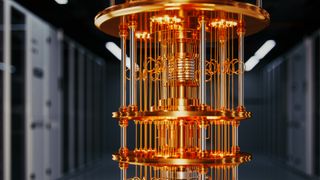
Quantum computing has always required advanced equipment housed in large laboratories, but new cloud technology may change that.
(Image credit: imaginima via Getty Images)
Researchers have developed a new communication paradigm that can let them securely connect a PC to a quantum computer over the internet.
Known as “blind quantum computing,” the technique uses a fiber-optic cable to connect a quantum computer with a photon-detecting device and uses quantum memory — the equivalent of conventional computing memory for quantum computers. This device is connected directly to a PC, which can then perform operations on the quantum computer remotely. The details were outlined in a new study published April 10 in the journal Physical Review Letters.
Quantum computers offer the potential for processing power that far outstrips conventional computers. But they are also incredibly delicate and need to be cooled to near absolute zero to prevent external interference with the quantum states. Conventional computers can connect to servers over the internet to store information and access processing power. However, there is always the risk that information could be intercepted.
Some companies offer quantum computing services through the cloud, including IBM and Amazon Web Services (AWS), although the scientists argue these aren’t 100% secure or scalable. Connecting a PC to a quantum computer using the new method, however, could provide a way for users to run a computation remotely but keep the structure hidden — while enabling verification of the computation by embedding hidden tests.
Related: Quantum computing breakthrough could happen with just hundreds, not millions, of qubits using new error-correction system
The quantum computer in the study used an electronic device called an ion trap. Using electric potentials, singly-charged ions of calcium and strontium (the qubits in the quantum computer) were captured by electrodynamic fields within the trap and then cooled to control the electronic states of the atoms and prevent them from escaping. The photons — which established the link between the quantum computer and the remote computer — were focused through a large objective lens into the optical fiber and then transmitted to the user.
In blind quantum computing, the user connects to the quantum computer over the internet using a photon-detecting and reconfiguring device to steer the qubits of the quantum computer. Therefore, the input, algorithms and output effectively become concealed from the quantum computer.
Get the world’s most fascinating discoveries delivered straight to your inbox.
“As the server has no idea about the data that it’s processing, that means we can run test runs on the quantum computers using algorithms where we already know the result,” lead author of the study Peter Drmota, postdoctoral research assistant at the University of Oxford, told Live Science. “If we interweave such test rounds with our actual algorithm, we can then gain confidence that the actual computation also returns valid results.”
The remote computer and the quantum computer continually exchange information throughout the computation. Consequently, the quantum memory stores the photonic states for longer than previously required, due to the ongoing communication. Transmissions between the PC and quantum computer are also encrypted using one-time pad encryption — a highly secure form of encryption.
“The traffic is distributed over the entire computation, but that also brings challenges with it, which we’re the first ones to address in the experiment,” said Drmota. “As it takes time for the communication to happen, we need to store the quantum memories for much longer than was previously possible. In our experiment, we had coherence times (the time the qubit stays alive and is not corrupted) up to 10 seconds.”
This also promises a highly secure method for communicating over the internet. In quantum computing, any attempt to copy or intercept data is detected, as any observation causes the quantum wave function to collapse and changes the underlying line state of the subatomic particles. Hence, if the server ever attempted to see what was going on then the data would become corrupted.
The scientists added that their method is highly scalable, unlike previous experiments based on photonic platforms without quantum memory, because the system is configured to avoid information losses. However, scaling also demands additional qubits to be added to the system and for error rates to be controlled. Although this adds challenges, such improvements would be at the quantum computer end, without requiring any changes by the remote user.
Blind quantum computing could become commercially available. All that would be needed to enable a secure connection with a quantum computer is a photon polarization measurement device plugged into a computer, plus a high-fidelity photonic link — such as a fiber-optic cable.
Peter is a degree-qualified engineer and experienced freelance journalist, specializing in science, technology and culture. He writes for a variety of publications, including the BBC, Computer Weekly, IT Pro, the Guardian and the Independent. He has worked as a technology journalist for over ten years. Peter has a degree in computer-aided engineering from Sheffield Hallam University. He has worked in both the engineering and architecture sectors, with various companies, including Rolls-Royce and Arup.
>>> Read full article>>>
Copyright for syndicated content belongs to the linked Source : Live Science – https://www.livescience.com/technology/computing/bizarre-device-uses-blind-quantum-computing-to-let-you-access-quantum-computers-from-home































